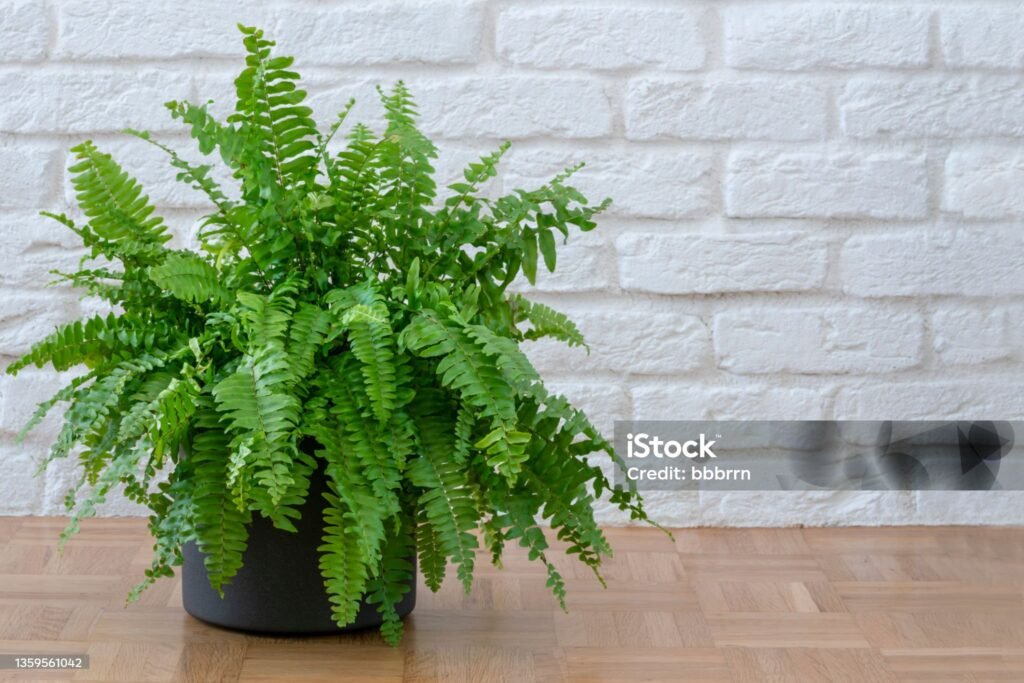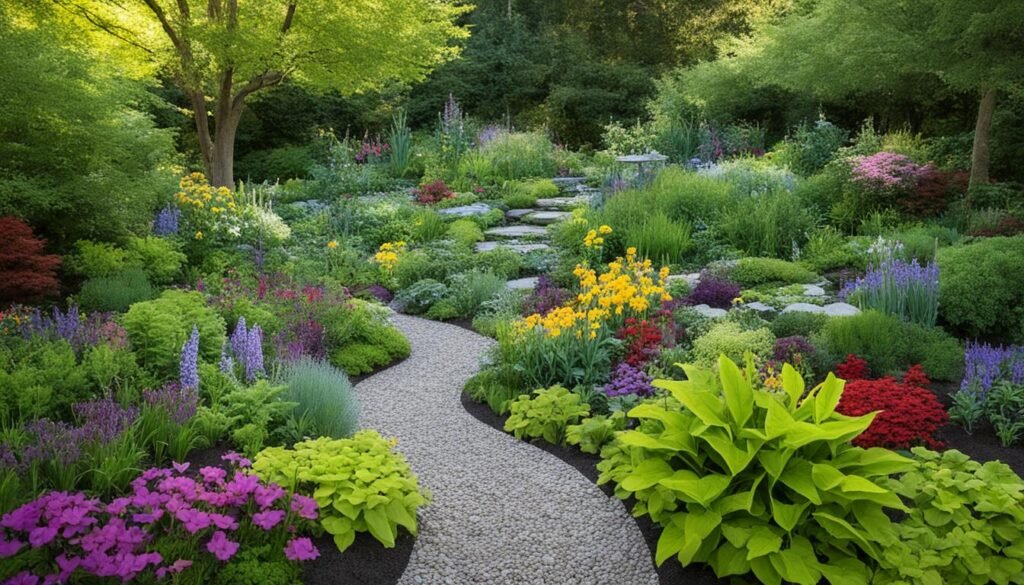Ever thought about having a garden inside with little sunlight? Many find it hard to pick the right indoor plants for low-light spots. But, there are plants that do well in little sunlight and need little care. This article will show you seven of these plants that can brighten your space with little work.
Benefits of Low-Light Plants in Home Decor
Adding low-light plants changes a room for the better. They are both beautiful and useful. Plants like snake plants and pothos are easy to care for and add green touches to your space. Here are some main benefits:
- Enhances aesthetic appeal through natural elements.
- Compatible with various interior styles, from modern to rustic.
- Low maintenance aligns perfectly with busy lifestyles.
How Low-Light Plants Improve Indoor Air Quality
Low-light plants are not just pretty. They clean the air we breathe. Plants like peace lilies and ZZ plants remove toxins from the air. This makes the air cleaner and healthier for you.
This makes low-light plants great for anyone wanting to improve their indoor gardening. They also help keep you and your family healthy.
Top 7 Indoor Plants That Thrive with Minimal Light
Indoor gardening is getting more popular, especially for those who want plants that do well in low light. Here are the top indoor plants that are easy to care for and look great in any space.
Snake Plant: The Ultimate Resilient Indoor Greenery
The Snake Plant, also known as Sansevieria, has striking, upright leaves. It’s a tough plant that can survive with little care, even in low light. It also needs less water and can handle different indoor conditions.
Pothos: The Beginner-Friendly Houseplant
Pothos is great for new gardeners. Its vines are pretty and grow well in soft light. It’s easy to care for, even if you forget to water it sometimes. This makes it perfect for busy people.
Zamioculcas zamiifolia (ZZ Plant): A Hardy Option
The ZZ Plant is a top choice for those who forget to water their plants. It has shiny leaves and can survive in low light. It’s great for dark corners of your home and doesn’t need much attention.
Peace Lily: A Beautiful Flowering Plant with Easy Care
The Peace Lily is loved for its white flowers and green leaves. It does well in low light and cleans the air. It only needs a little water, making it simple for anyone to care for.
Cast Iron Plant: The No-Fuss Champion
The Cast Iron Plant is very hard to kill. It likes low light and has green leaves that fit any decor. It can survive with little care and less water, making it ideal for busy people.
Spider Plant: Perfect for Small-Space Gardening
The Spider Plant is great for small spaces. It has long leaves and produces baby plants. It grows in different lights and is easy to care for, making it perfect for both new and experienced gardeners.
Boston Fern: The Shade-Tolerant Favorite
The Boston Fern adds a tropical look to any room. It grows in soft light and likes moist air. It requires a bit more care than some plants but is worth it for its beauty.
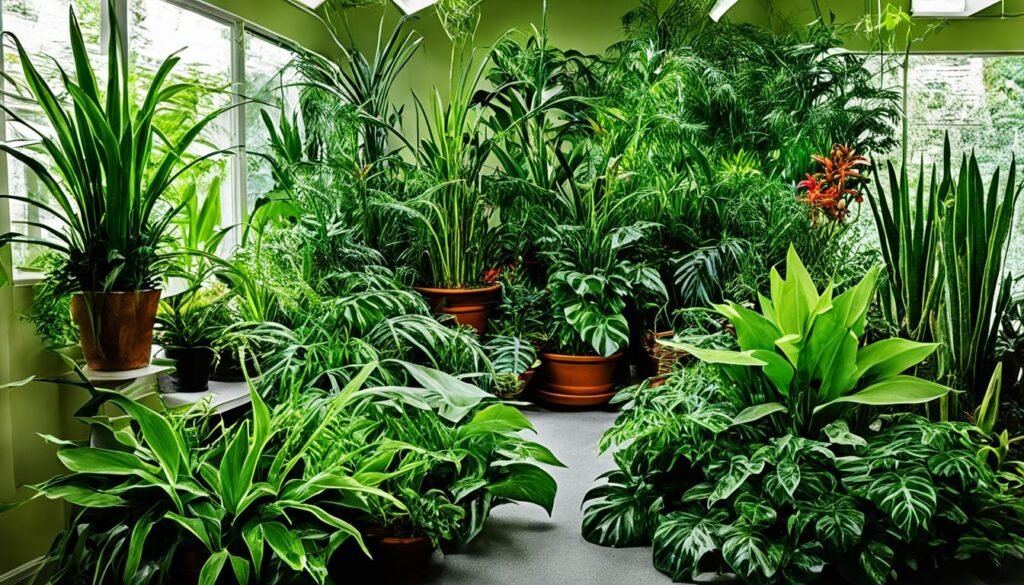
| Plant Name | Light Requirements | Watering Needs | Key Benefits |
|---|---|---|---|
| Snake Plant | Low to indirect light | Minimal | Air purification, hardy |
| Pothos | Indirect light | Low | Cascading vines, forgiving |
| ZZ Plant | Low light | Very low | Glossy leaves, resilient |
| Peace Lily | Low to indirect light | Low | Beautiful blooms, air purification |
| Cast Iron Plant | Low light | Very low | Tough, low maintenance |
| Spider Plant | Varied light | Minimal | Children, air purifier |
| Boston Fern | Indirect light | Moderate | Lush foliage, humidity loving |
Indoor Plant Care Tips for Low-Maintenance Houseplants
Caring for low-water houseplants is easy with the right tips. Knowing what these plants need helps them stay healthy and long-lived. It also helps avoid common mistakes in plant care.
Watering: Finding the Right Balance
Mastering watering is key for indoor plants. Don’t overwater, or you might cause root rot. Let the soil dry out a bit before watering again. Check the top inch of soil; if it’s dry, it’s time to water.
Change how often you water based on the plant’s spot, light, and temperature. This keeps your plants happy.
Fertilizing Low-Light Indoor Plants
For low-light plants, a little fertilizer goes a long way. Use a weak, balanced fertilizer when they’re growing. Feed them every 4-6 weeks. Always follow the instructions to avoid harming your plants.
Pruning and Maintenance for Easy-Care Plants
Pruning keeps your plants healthy and encourages new growth. Cut off dead or yellow leaves to help the plant. Dusting leaves also helps them get the light they need.
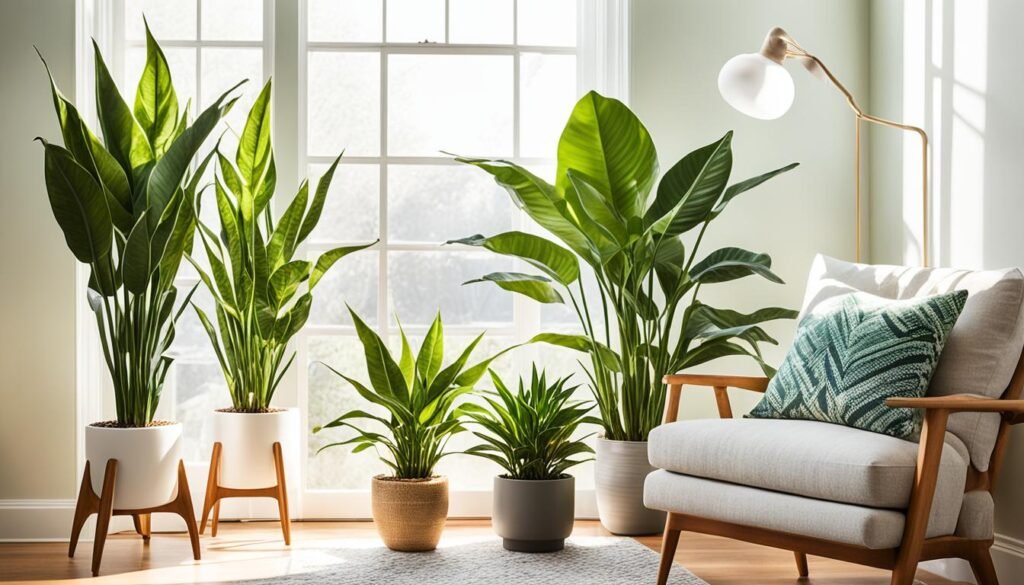
| Plant Type | Watering Frequency | Fertilizing Schedule | Pruning Needs |
|---|---|---|---|
| Snake Plant | Every 2-3 weeks | Every 6-8 weeks in summer | Light pruning for dead leaves |
| Pothos | Once a week | Every 4-6 weeks | Trim as needed for shape |
| ZZ Plant | Every 2-3 weeks | Once every 6 months | Minimal pruning |
| Peace Lily | When the soil is dry | Every 6-8 weeks in growing season | Remove spent flowers and yellow leaves |
| Cast Iron Plant | Every 2-3 weeks | Every 4 months | Only for dead or damaged leaves |
Creating a Humid Environment for Your Indoor Plants
Keeping the right humidity is key for indoor plants, especially those needing little light. It helps with moisture control, which is vital for plant health. The right humidity helps plants absorb water and breathe better.
This part talks about why humidity matters and how to make your home more humid for your plants.
The Role of Humidity in Plant Growth
Humidity is crucial for plant health. Most plants do well in 40% to 60% humidity. If it’s too low, plants may wilt or grow slowly. This is true for tropical plants that love more moisture.
By controlling humidity, you help your plants stay healthy and full of life.
Tips for Moisture Control in Your Home
Improving moisture at home helps your plants a lot. Here are some ways to do it:
- Use a humidifier to keep humidity steady, especially in dry seasons.
- Group plants together to create a humid spot.
- Put trays of water near your plants to increase humidity as water evaporates.
- Avoid putting plants near heating vents, which can dry them out.
- Regularly mist your plants to add humidity, especially in the summer.

Decorating Your Space with Low-Maintenance Houseplants
Adding low-maintenance houseplants to your space makes it lively and looks better. It’s important to pick the right containers and arrange them well. Here are some tips to make your indoor plants look great.
Choosing the Right Containers for Your Plants
Choosing the right containers makes your houseplants look better. Think about these things:
- Material: Pick pots from clay, ceramic, or things that break down to match your style.
- Size: Make sure the pot is the right size for your plant to grow.
- Drainage: Choose pots with holes for water to prevent your plants from getting too wet.
Arranging Plants for Maximum Aesthetic Appeal
Putting your plants in the right spots makes your space welcoming. Here are some tips:
- Put plants of different heights together for more interest.
- Mix different textures and colors for a lively look.
- Use stands or shelves to add height to your plants.
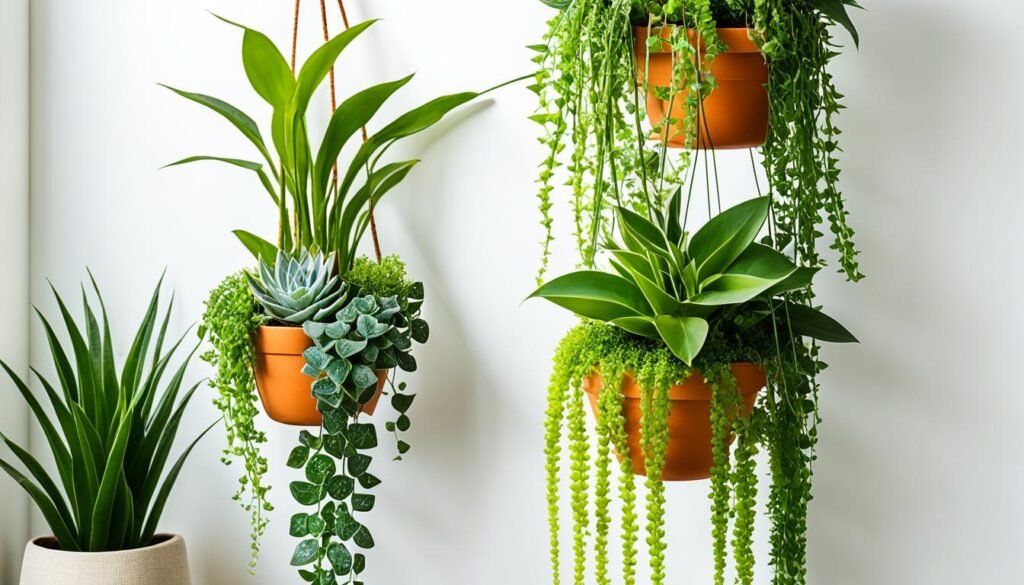
Try different ways of arranging your plants to find what looks best. This will show off your low-maintenance houseplants and make your space look better.
| Container Material | Key Benefits |
|---|---|
| Clay | Good for air circulation and moisture retention. |
| Ceramic | Available in various styles and colors for diverse aesthetics. |
| Biodegradable | Environmentally friendly option that decomposes naturally. |
Think about these things when picking containers and arranging your plants. This way, you can make a beautiful indoor garden that shows off your style and the beauty of low-maintenance houseplants.
Indoor Plant Ideas for Small Spaces
Turning small areas into green spaces is fun for plant lovers. Using small-space gardening lets you be creative and make the most of little room. With the right plants and setup, your home can look beautiful.
Vertical Gardening: Utilizing Wall Space
Vertical gardening is a great way to garden in small spaces. It lifts your plants up, saving floor space and looking amazing. You can use wall planters or shelves to grow plants like Pothos or small flowers.
- Wall planters to create a living green wall.
- Hanging pots to use overhead space.
- Vertical racks for succulents and herbs.
Combining Plants for Visual Interest
Mixing different plants adds depth and character to your space. Choose plants with various shapes, colors, and sizes for interesting arrangements. Here are some tips for combining plants well:
- Pair large, leafy plants like the Snake Plant with smaller, cascading varieties such as the Spider Plant.
- Mix flowering plants, such as Peace Lilies, with lush green foliage to bring vibrancy.
- Use contrasting colors and textures to highlight the unique features of each plant.
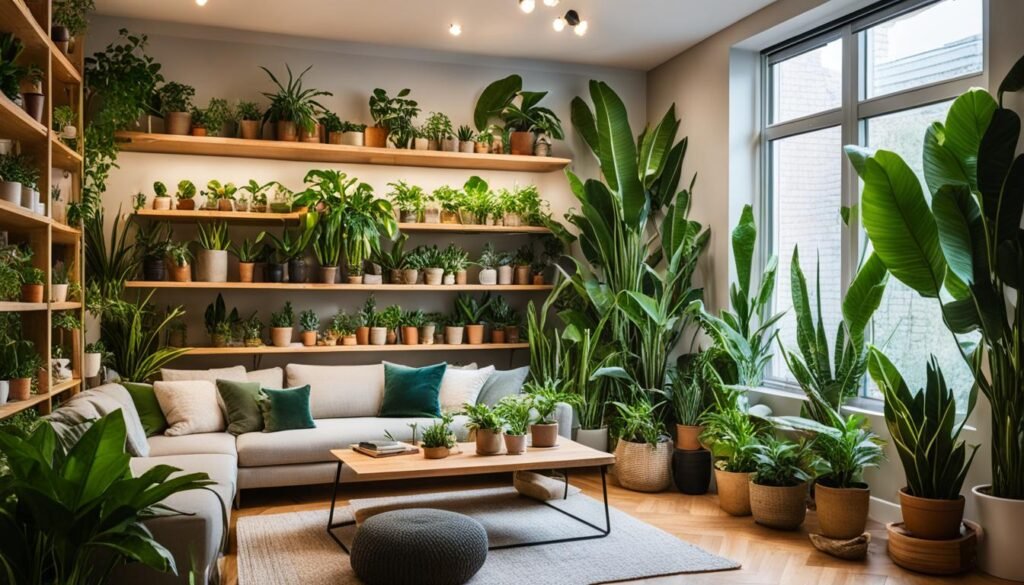
Comparing Low-Light Plants for Different Settings
Choosing the right low-light plants can make homes and offices better. Some plants are great for workspaces that need calmness and productivity. Others are perfect for homes that want beauty and comfort. Knowing which plants to pick can make your space peaceful or lively.
Home vs. Office: Which Plants Are Best?
When picking indoor plants, think about the light, humidity, and space. Here’s a chart with good options for homes and offices:
| Plant Name | Best Setting | Type | Care Level |
|---|---|---|---|
| Snake Plant | Both | Office plants | Low |
| Pothos | Both | Indoor plant inspiration | Low |
| Peace Lily | Home | Flowering plant | Moderate |
| Boston Fern | Home | Shade-tolerant plants | Moderate |
| ZZ Plant | Office | Office plants | Low |
Creating a Relaxing Space with Indoor Greenery
Indoor plants can make any space better. At home, plants like pothos or snake plants make it cozy and calm. In offices, they help reduce stress, improve focus, and boost productivity. Here are tips to make your plants stand out:
- Group plants together for a calming effect.
- Put plants near windows for natural light.
- Choose pots that match your style.
- Use big plants in corners to fill empty spots.
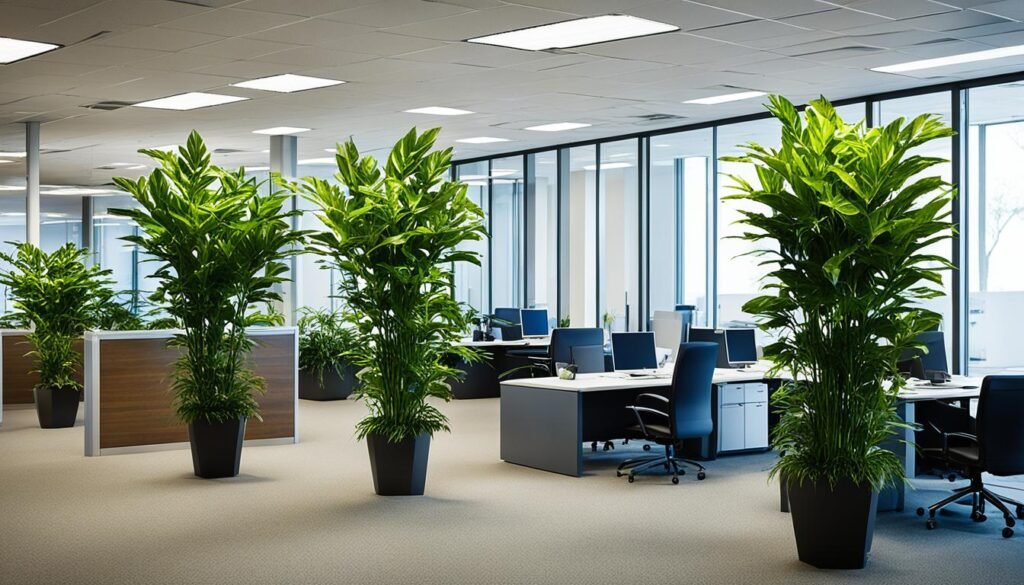
Conclusion
Adding indoor plants to your home or office can make a big difference. Choosing easy-care indoor plants that do well in low light is a great idea. These plants make your space look better and help improve the air you breathe.
By learning about the benefits of low-light plants and how to care for them, anyone can start gardening indoors easily. We looked at plants like the Snake Plant, Pothos, and Peace Lily. These plants are easy to take care of and can brighten up any room.
Start making your space greener today with these low-light plants. They need little care but look amazing. Adding these plants to your decor is a simple way to enjoy gardening indoors without much work.
FAQ
What are some indoor plants that thrive in low light?
Great choices for low-light include the Snake Plant, Pothos, ZZ Plant, and Peace Lily. These plants are tough and do well with little sunlight.
How can I care for low-maintenance houseplants?
Take care of low-maintenance houseplants by watering right, not too much. Don’t overdo it on the fertilizer, and trim them now and then. Pick plants that fit your life for the best care.
Do low-light plants improve indoor air quality?
Yes, low-light plants clean the air, removing pollutants. This makes your home’s air cleaner and healthier.
Can I grow indoor plants in a small apartment?
Yes! Small spaces can have many indoor plants. Use vertical gardening and creative plant arrangements to decorate without taking up too much space.
What are some easy-care indoor plants for beginners?
Pothos, Snake Plant, and Spider Plant are great for beginners. They need little care, adapt to many conditions, and bounce back from common problems.
How do I create humidity for my indoor plants?
Create humidity by putting plants close together, using a humidifier, or placing a water tray with pebbles near them. This keeps moisture levels that many plants prefer.
What are shade-tolerant plants suited for office spaces?
For offices, try the ZZ Plant, Snake Plant, and Peace Lily. They handle little sunlight well and make work spaces calm.
How do I arrange my indoor plants for visual appeal?
Arrange plants by height and style for visual interest. Group them by size and shape. Use stands or shelves to add depth and make your space welcoming.
